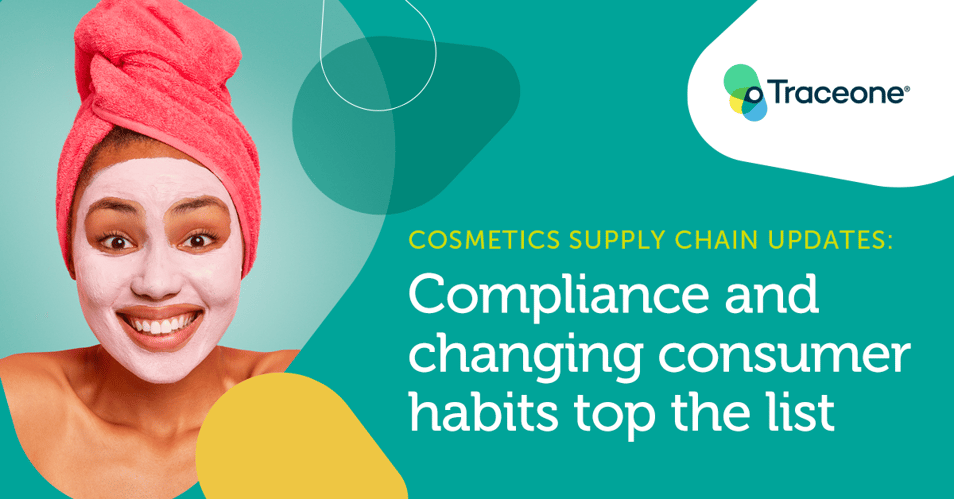
- Home
- PLM & Compliance Blog
- Cosmetics supply chain updates: Compliance and changing consumer habits top the list
Cosmetics supply chain updates: Compliance and changing consumer habits top the list
|
Product Lifecycle Management
Posted By:
Trace One
Managing regulations and meeting lightning- fast “Beauty-Tok” trends challenge cosmetics and formulations manufacturers’ product lifecycle management (PLM)
The Cosmetics Supply Chain Act of 2023 (bill H.R. 3622) will entitle cosmetics and formulations manufacturers for cosmetics and personal care products additional transparency from their suppliers, formulating laboratories and packaging vendors.
Suppliers will have 90 days to deliver information upon request about chemical identity numbers, fragrance allergen statements, and the like. After all, it’s the brands themselves who are open to liability from FDA actions or civil lawsuits if product safety is compromised.
If cosmetics business leaders do not have an easy way to manage supplier quality, they’ll have difficult time ensuring all future and current safety standards are met. Managing supplier requests now and in the future should be expedited and efficient to help meet consumer companies’ commitment to quality and to delivering the best possible product they can.
Mastering materials, marketplace reputation, consumer safety
Improving cross functional communication about these materials management issues can protect marketplace reputation and, with resulting improvements to PLM workflows, deliver a new competitive edge. Regulatory needs require supply chain resiliency—keeping track of dual sourcing options in case a supplier network is compromised or consumer needs are shifting, assuring consumer safety. So do the ever-changing consumer trends surfaced on TikTok and across other influential platforms. If a cosmetics company can’t create a “jelly donut” nail polish before consumer preference turns to “mermaid nails” they’ll risk losing an entire generation of consumers. According to a 2023 Statista survey, “around 83 percent of Gen Z women bought beauty products online because content creators recommended them. TikTok is currently the most prominent platform for beauty purchases. Around 53 percent of Gen Z consumers go to the app for beauty purchase inspiration.”
So how does a cosmetics company respond to supply chain challenges from both regulators and consumers within their product lifecycle management process?
Strengthening every link in the supply chain
“Supply chain partner management must be digitized and centralized to include every element of ideation, launch, production and the maintenance of every product,” said one large cosmetics manufacturer. “Harmonizing all of our supply chain activities in a PLM system created a way to trace regulatory activities and every risk to product launch, so we could react to consumer trends in time.”
Most supply chain managers would agree: An end-to-end PLM within their larger system helps with collaborative efforts in these two crucial areas. Supplier relationships are strengthened as each person who interacts within the system sees the same version of the truth. Requesting ingredients information from suppliers should be an automated workflow. The suppliers’ answers back then can be accessed by whomever needs them.
“Our current formulations library in Trace One manages what used to be a manual process. We also have a SKU library tracking QA data and a way to label and package products within every harmonized launch,” said the cosmetics and beauty brand leader about Trace One PLM.
Suppliers and their customers in the cosmetics and personal care industry build resiliency together when they can both process operational data in a PLM. This harmonizes ingredient delivery and helps formulations engineers iterate and innovate more readily with a transparent, compliant supplier network.
Agile supply chains for Gen X, Z fragrance, beauty, skincare flaws
In a recent survey from Lending Tree, three-quarters of Americans (75%) said beauty products, cosmetics and services are important to them, as proven by consumers spending an average of $1,754 a year on related purchases. That rises with younger generations to an average of $2,670 among millennials and $2,048 among Gen Zers. What’s more, 46% of Americans say social media has influenced them to spend more on beauty.
Integrated demand forecasting for every supplier in a cosmetics company’s network will enable them to meet consumers who encounter new beauty trends every day on TikTok. And analytics measuring supplier capacity and consistency make for an agile supply chain, ready to pivot to launch, taking advantage of the latest and greatest trend.
“Our PLM system includes reporting and analytics for suppliers---for every step in the product lifecycle, in fact. From suppliers to internal resource management, to costs, to improving workflows, Trace One PLM has given us a new level of visibility and control. Luxury beauty and skincare competes every day for share of mind in our super-competitive marketplace. Improving PLM is an important differentiator for us,” said a luxury cosmetics brand leader.
This Trace One customer is poised for an unprecedented season of growth and global expansion. With a high profile on social media, they required expansive analytics to decide where, when and how to launch in different regions, and with which product lines. Of course, there are many more data points to track outside of PLM—but PLM will ground teams firmly in the center of innovation, thanks to internal synchronization around product development, production and commercialization.
“We know that our innovation cycle is stronger. We know our suppliers are on board and that we have a way of making sure the materials we source from them meet all safety standards, and of course, our high standards for our products and for the people who use them. We also know that the first three launches we did using Trace One PLM were unbelievably easier and more effective than ever,” said this company’s PLM leader.
